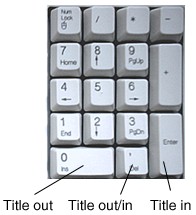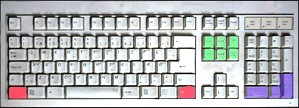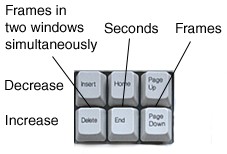Word processing is done in edit mode in the edit window.
TitleVision offers a plethora of new and old word processing routines. Thanks to the virtually limitless Undo/Redo feature there's no danger in experimenting, so go ahead! Split a line, and the continuation dashes will be set for you, even in italicized subtitles. Merge two subtitles, and the dashes will magically disappear. With one keystroke you may toggle both dialog dashes in subtitles spoken by two persons. Do you want to convert a subtitle to UPPER CASE? No problem. Do you need to replace a name throughout a whole movie? Consider it done.
Check out a list of all the word processing commands here.
Cueing is done in display mode or edit mode
There probably are as many cueing techniques as there are subtitlers, but most can be placed in one of two categories:
• The time code is captured on the fly while the video source is running
• The time code is typed manually or captured from a paused video picture.
Most subtitlers use a combination of the two.
Capturing time code on the fly in Display Mode

Pressing the in cue key (ENTER on the numeric keypad) will make the running time code the in cue of the first cueless subtitle found, making this subtitle pop up in the edit window, where it will remain until the out cue key (0/INS on the numeric keypad) is pressed, making the running time code the out cue of the subtitle.
Or put simply: The subtitle will pop up on the screen when the in cue key is pressed and disappear when the out cue key is pressed.
If the time bar is activated it will run along during this process as a visual aid for determining the readability of the subtitle.
That's actually all there is to it. The technique is easy, but it takes a lot of practice to master it to a degree of actually being able to tell the exact number of frames between a subtitle and a scene end.
The ./DEL key between ENTER and 0/INS offers a shortcut, performing in one keystroke what amounts to an out cue keypress and an in cue keypress with the minimum interval value inbetween.
If ENTER is pressed prematurely, just press it again and a new in cue will be captured.
The mouse may also be used for cueing, and there are alternative keys in the format menu that may be reconfigured to anything you like.
It is also possible to switch the Title in and Title out keys via Toggle settings
Recueing is possible when either of the two Ctrl keys is pressed or a reconfigurable key combination from the format menu is used.
If Ctrl is pressed between subtitles the registered in cue is overridden. Therefore the next subtitle will not be exposed till Enter (NumPad) is pressed, but as soon as this happens a new in cue will be registered and the time bar will start running (if activated). The subtitle will be exposed, until Ctrl is released or an out cue is entered.
If Ctrl is pressed while a subtitle is exposed the registered out cue, if any, is overridden. Therefore the time bar will start running (if activated). If an out cue is entered it will be registered. It is also possible to enter a new in cue at this point by pressing Enter (NumPad). If this happens the old in cue is overridden and the new one is registered, and the time bar will start running from its outset again, until a new out cue is entered or the old out cue is sanctioned by the release of Ctrl.

The manual approach in Edit Mode
Time code may be captured from a still picture in Edit Mode with the same keys as in Display Mode OR Shift+F9 (in cue), Shift+F10 (out cue) or Shift+11 (out cue plus next in cue). It may also be captured with the mouse by clicking the mode indicator: Shift+click captures in time, and Ctrl+click captures out time from a frozen still. Time code may also be captured by clicking thumbnails.
It's also possible to type in time code manually in the in cue and out cue windows. This process is slow and time consuming and should only be used for corrections.
Whenever a cue window is activated the TitleVision system offers a choice of six keys to speed up things:

• PAGE UP: decrease frames
• PAGE DOWN: increase frames
• HOME: decrease seconds
• END: increase seconds
• INSERT: simultaneously decrease frames in the active cue window and the one immediately above or below it.
• DELETE:simultaneously increase frames in the active cue window and the one immediately above or below it.
• ENTER: confirm changes and leave cue window
Other shortcuts for fast rearranging of time code:
Fit previous out cue to in cue (Ctrl+F9)
Fit next in cue to out cue (Ctrl+F10)
Dummy cueing
Though most subtitlers prefer writing their subtitles before cueing them, the big advantage of cueing before writing is that you get to know the duration of the subtitle before choosing the wording - a great help in the shortening process. A file (dummy.pac) for this purpose is included in the TitleVision software package. You'll find it in the DATA subdirectory.
Fitting cues to scene changes
In Sub Machine this is being done automatically by the computer. Sometimes the machine finds each and every scene change, sometimes it is harder, if the movie is very dark or in letterbox format with two unmoving black bars covering maybe half the screen. Then you have to find them yourself, but the video cache system makes it a cinch compared to the old rewind-tape-and-step-forward-frame-by-frame method.
If for example you want to check the cueing around a scene change, you stop the film by pressing Numpad5, choose the in time window by pressing F9 and move previous out time/current in time back and forth by pressing Insert and Delete (In time only: PageUp and PageDown). Once the scene change is found you can keep the change by:
•Pressing Enter
•Pressing Numpad5 (at the same time activating Play)
•Pressing Numpad4 (at the same time going one second back to actually see what has been changed).
If thumbnails are activated, its even easier. Then you can actually see the scene changes and capture the cues with the mouse. Read all about it here.
You can also mouse drag in and out cues on the audio graph.
See also: